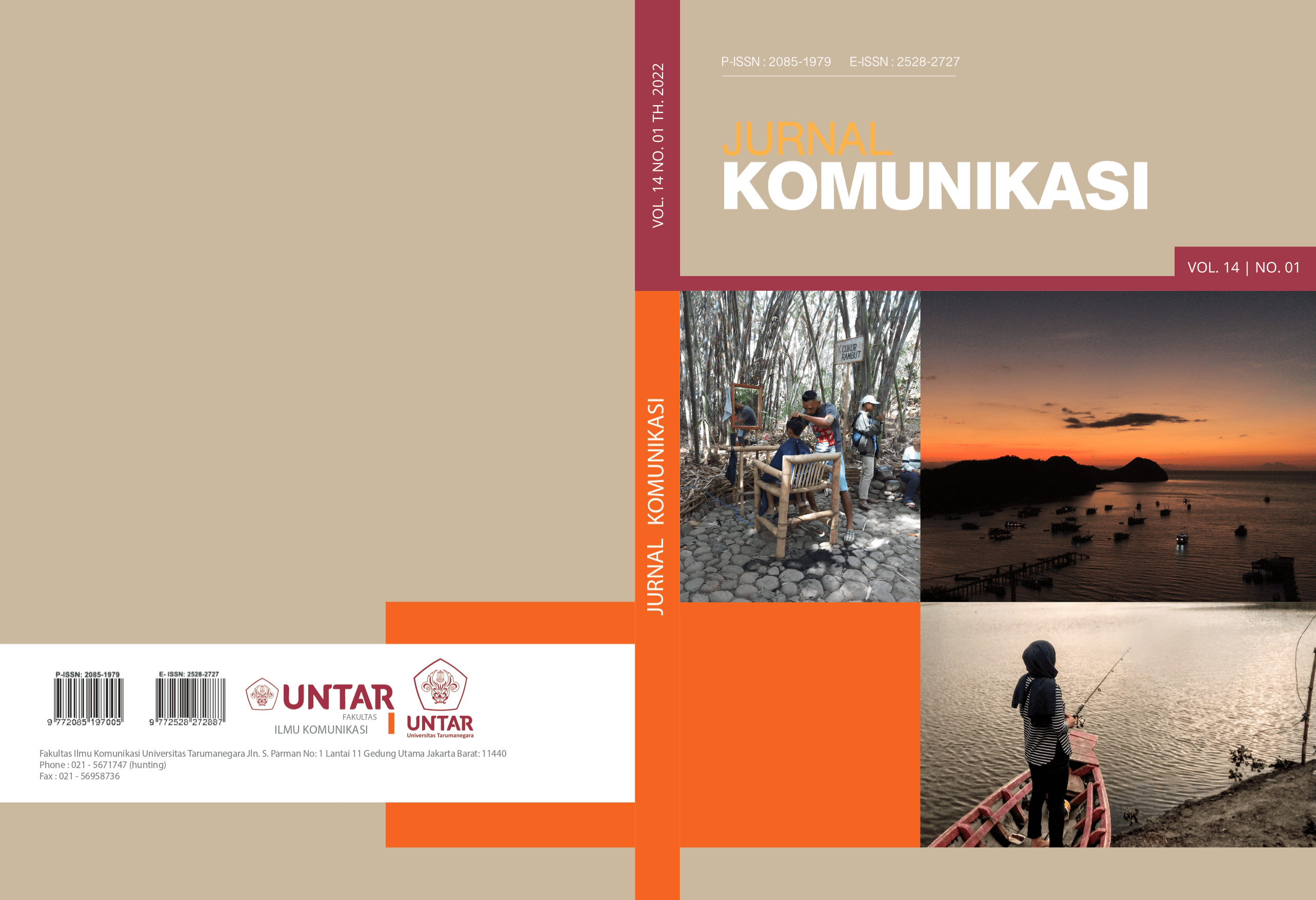Social Media Movement and Covid-19 Prevention in Indonesia
Main Article Content
Abstract
Article Details
Section

This work is licensed under a Creative Commons Attribution-ShareAlike 4.0 International License.
This work is licensed under a Jurnal Komunikasi Creative Commons Attribution-ShareAlike 4.0 International License.How to Cite
References
Anwar, R. K., & Rusmana, A. (2017). KOMUNIKASI DIGITAL BERBENTUK MEDIA SOSIAL DALAM MENINGKATKAN KOMPETENSI BAGI KEPALA, PUSTAKAWAN, DAN TENAGA PENGELOLA PERPUSTAKAAN SEKOLAH/MADRASAH DI DESA KAYU AMBON, KECAMATAN LEMBANG KABUPATEN BANDUNG BARAT. Dharmakarya, 6(4).
Bahtiar, R. A., & Saragih, J. P. (2020). DAMPAK COVID-19 TERHADAP PERLAMBATAN EKONOMI SEKTOR UMKM. INFO Singkat Kajian Singkat Terhadap Isu Aktual Dan Strategis, XII(6), 19–24.
Dessart, L. (2017). Social media engagement : a model of antecedents and relational outcomes relational outcomes. Journal of Marketing Management, 00(00), 1–25. https://doi.org/10.1080/0267257X.2017.1302975
Eka, A. G., & Wuryanta, W. (2013). Digitalisasi Masyarakat : Menilik Kekuatan dan Kelemahan Dinamika Era Informasi Digital dan Masyarakat Informasi. Jurnal Ilmu Komunikasi, 1(2), 131–142.
Eriyanto, E. (2020). Hashtags and Digital Movement of Opinion Mobilization: A Social Network Analysis/SNA Study on# BubarkanKPAI vs# KamiBersamaKPAI Hashtags. Jurnal Komunikasi Indonesia, 167–178.
Freberg, K., Graham, K., McGaughey, K., & Freberg, L. A. (2011). Who are the social media influencers? A study of public perceptions of personality. Public Relations Review, 37(1), 90–92.
Girsang, C. N., & Kartikawangi, D. (2021). Two-Way Symmetrical Communication Pattern : Company Strategy to Build Engagement Through Social Media Pola Komunikasi Simetris Dua Arah : Strategi Perusahaan Membangun Engagement Melalui Media Sosial. Jurnal Komunikasi, 13(2), 271–286.
Hasiholan, T. P., Pratami, R., & Wahid, U. (2020). Pemanfaatan media sosial tik tok sebagai media kampanye gerakan cuci tangan di indonesia untuk pencegahan corona covid - 19 1). 5(2), 70–80.
Hou, M. (2019). Social Media Celebrity and The Institutionalization of YouTube. Journal of Research into New Media Technologies, 25(3), 534–553. https://doi.org/10.1177/1354856517750368
Islam, S., Sarkar, T., Khan, S. H., Kamal, A. M., Hasan, S. M. M., Kabir, A., … Seale, H. (2020). COVID-19 – Related Infodemic and Its Impact on Public Health : A Global Social Media Analysis. The American Society of Tropical Medicine and Hygiene, 103(4), 1621–1629. https://doi.org/10.4269/ajtmh.20-0812
Loh, J. (2013). Inquiry into issues of trustworthiness and quality in narrative studies: A perspective. Qualitative Report, 18(33). https://doi.org/10.46743/2160-3715/2013.1477
Martono, N. (2010). Metode penelitian kuantitatif: Analisis Isi dan Analisis Data Sekunder (sampel halaman gratis). RajaGrafindo Persada.
Nowakowska, J., Soboci?ska, J., Lewicki, M., Lema?ska, ?., & Rzymski, P. (2020). When science goes viral : The research response during three months of the COVID-19 outbreak. Biomedicine & Pharmacotherapy, 129(June), 110451. https://doi.org/10.1016/j.biopha.2020.110451
Nurhajati, L., Sukandar, R., Oktaviani, R. C., & Wijayanti, X. A. (2020). Perbincangan Isu Corona COVID-19 di Media Daring dan Media Sosial di Indonesia.
Piliang, Y. A. (2012). MASYARAKAT INFORMASI DAN DIGITAL : Teknologi Informasi dan perubahan Sosial. Jurnal Sosioteknologi, 143–156.
Prihantoro, E., Rakhman, F. R., & Ramadhani, R. W. (2021). Digital Movement of Opinion Mobilization : SNA Study on # Dirumahaja Vs . # Pakaimasker Gerakan Digital Mobilisasi Opini : Studi SNA # Dirumahaja Vs # Pakaimasker. Jurnal ASPIKOM, 6(1), 77–93.
Rohmah, N. N. (2020). Media Sosial Sebagai Media Alternatif Manfaat dan Pemuas Kebutuhan Informasi Masa Pandemik Global Covid 19 ( Kajian Analisis Teori Uses And Gratification ). Al-I’lam : Jurnal Komunikasi Dan Penyiaran Islam, 4(1), 1–16.
Rumata, V. M. (2017). ANALISIS ISI KUALITATIF TWITTER “# TaxAmnesty” DAN “# AmnestiPajak” A QUALITATIVE CONTENT ANALYSIS OF TWITTER “# TaxAmnesty” AND “# AmnestiPajak.” Jurnal PIKOM (Penelitian Komunikasi Dan Pembangunan), 18(1).
Satuan Tugas Penanganan Covid-19. (2021). Data Sebaran. Retrieved from https://covid19.go.id
Tania, S. (2020). Zainuddin Muda Z. Monggilo| Mashita Fandia Syaifa Tania| Gilang Desti Parahita| Widodo Agus Setianto Muhamad Sulhan| Rajiyem| Novi Kurnia.
Uzuno?lu, E., & Kip, S. M. (2014). Brand communication through digital influencers: Leveraging blogger engagement. International Journal of Information Management, 34(5), 592–602.
Wang, X., Yu, C., & Wei, Y. (2012). Social media peer communication and impacts on purchase intentions: A consumer socialization framework. Journal of Interactive Marketing, 26(4), 198–208.
Winanti, P. S., & Mas’udi, W. (2020). Problem Infodemic dalam Merespon Pandemi Covid-19 (Vol. 3).
Zarei, K., Farahbakhsh, R., Crespi, N., & Tyson, G. (2020). A first Instagram dataset on covid-19. ArXiv Preprint ArXiv:2004.12226

